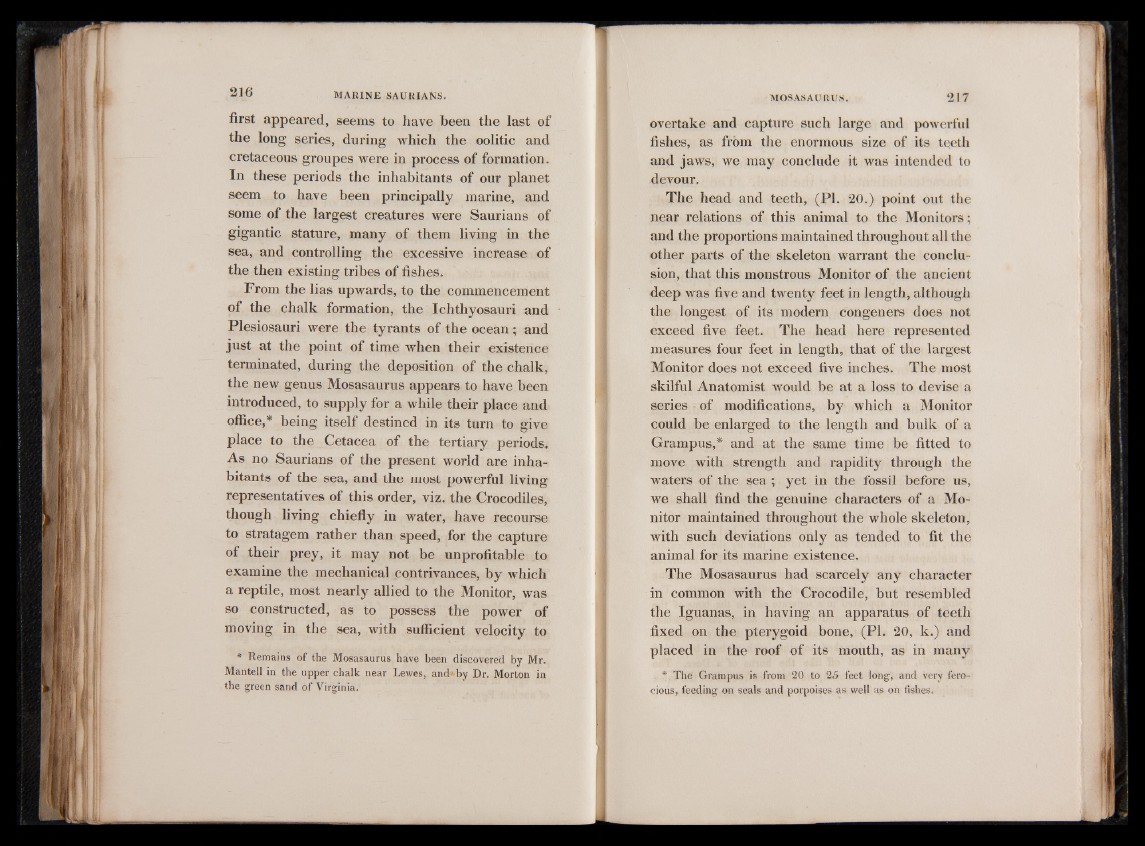
first appeared, seems to have been the last of
the long series, during which the oolitic and
cretaceous groupes were in process of formation.
In these periods the inhabitants of our planet
seem to have been principally marine, and
some of the largest creatures were Saurians of
gigantic stature, many of them living in the
sea, and controlling the excessive increase of
the then existing tribes of fishes.
From the lias upwards, to the commencement
of the chalk formation, the Ichthyosauri and
Plesiosauri were the tyrants of the ocean ; and
just at the point of time when their existence
terminated, during the deposition of the chalk,
the new genus Mosasaurus appears to have been
introduced, to supply for a while their place and
office,5,6 being itself destined in its turn to give
place to the Cetacea of the tertiary periods.
As no Saurians of the present world are inhabitants
of the sea, and the most powerful living
representatives of this order, viz. the Crocodiles,
though living chiefly in water, have recourse
to stratagem rather than speed, for the capture
of their prey, it may not be unprofitable to
examine the mechanical contrivances, by which
a reptile, most nearly allied to the Monitor, was
so constructed, as to possess the power of
moving in the sea, with sufficient velocity to
* Remains of the Mosasaurus have been discovered by Mr.
Mantell in the upper chalk near Lewes, and»by Dr. Morton in
the green sand of Virginia.
overtake and capture such large and powerful
fishes, as from the enormous size of its teeth
and jaws, we may conclude it was intended to
devour.
The head and teeth, (PI. 20.) point out the
near relations of this animal to the Monitors;
and the proportions maintained throughout all the
other parts of the skeleton warrant the conclusion,
that this monstrous Monitor of the ancient
deep was five and twenty feet in length, although
the longest of its modern congeners does not
exceed five feet. The head here represented
measures four feet in length, that of the largest
Monitor does not exceed five inches. The most
skilful Anatomist would be at a loss to devise a
series - of modifications, by which a Monitor
could be enlarged to the length and bulk of a
Grampus,* and at the same time be fitted to
move with strength and rapidity through the
waters of the sea; yet in the fossil before us,
we shall find the genuine characters of a Monitor
maintained throughout the whole skeleton,
with such deviations only as tended to fit the
animal for its marine existence.
The Mosasaurus had scarcely any character
in common with the Crocodile, but resembled
the Iguanas, in having an apparatus of teeth
fixed on the pterygoid bone, (PI. 20, k.) and
placed in the roof of its mouth, as in many
* The Grampus is from 20 to 25 feet long, and very ferocious,
feeding on seals and porpoises as well as on fishes.